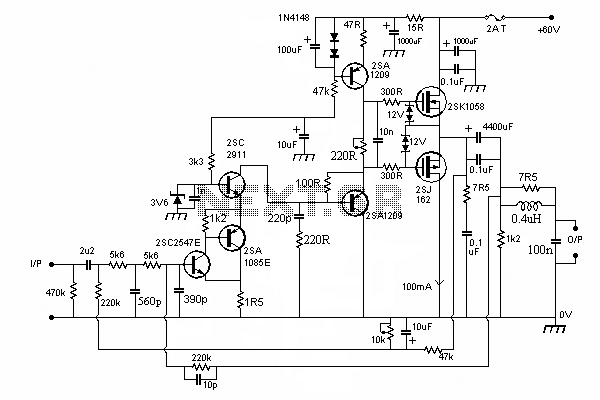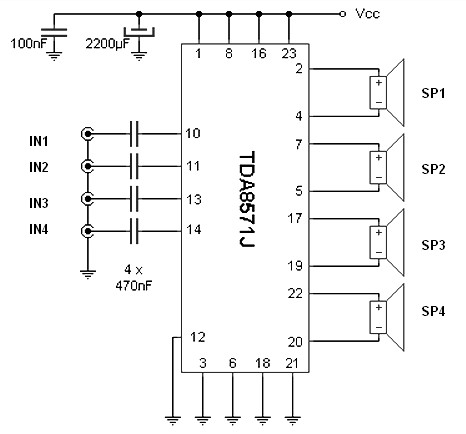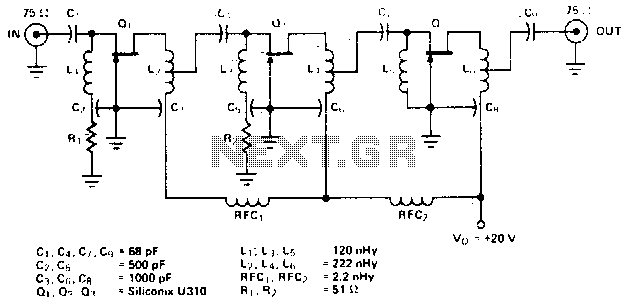
4 watt 900mhz rf amplifier
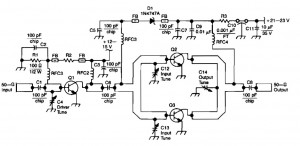
This RF amplifier circuit delivers a power output of 4 Watts at a frequency of 900 MHz. It utilizes Wilkinson power dividers in the base and collector circuits of transistors Q2 and Q3. Two SD1853 driver application transistors are paralleled to achieve double the power output of the 2-Watt amplifier.
The RF amplifier circuit is designed to operate efficiently at a frequency of 900 MHz, making it suitable for various wireless communication applications. The use of Wilkinson power dividers in the circuit is critical for achieving balanced power distribution and minimizing signal reflections. These dividers ensure that the input power is evenly split between the two driver transistors, Q2 and Q3, which are both SD1853 types.
The SD1853 is specifically chosen for its high gain and efficiency, enabling the amplifier to produce a total output of 4 Watts. By paralleling two of these transistors, the circuit effectively doubles the power output compared to a single transistor configuration, which typically provides around 2 Watts. This parallel arrangement also aids in thermal management, as the heat generated by each transistor is distributed across both devices, enhancing reliability and longevity.
The design of the circuit should include careful consideration of the matching networks to optimize the input and output impedances, ensuring maximum power transfer and minimal signal loss. Additionally, bypass capacitors may be implemented to filter out any noise from the power supply, providing a cleaner signal output. The layout of the circuit board is also crucial, as it must minimize parasitic inductance and capacitance, which can adversely affect performance at high frequencies.
Overall, this RF amplifier circuit is engineered to deliver robust performance in RF applications, leveraging innovative design techniques such as power division and transistor paralleling to achieve high power output while maintaining signal integrity.This RF amplifier circuit has a power output of 4 Watts at a frequency of 900 Mhz. Applying Wilkinson power dividers in the base and collector circuits of Q2 and Q3, a couple of SD1853 driver application transistor are paralleled for double the power output of the 2-W amplifier. 🔗 External reference
The RF amplifier circuit is designed to operate efficiently at a frequency of 900 MHz, making it suitable for various wireless communication applications. The use of Wilkinson power dividers in the circuit is critical for achieving balanced power distribution and minimizing signal reflections. These dividers ensure that the input power is evenly split between the two driver transistors, Q2 and Q3, which are both SD1853 types.
The SD1853 is specifically chosen for its high gain and efficiency, enabling the amplifier to produce a total output of 4 Watts. By paralleling two of these transistors, the circuit effectively doubles the power output compared to a single transistor configuration, which typically provides around 2 Watts. This parallel arrangement also aids in thermal management, as the heat generated by each transistor is distributed across both devices, enhancing reliability and longevity.
The design of the circuit should include careful consideration of the matching networks to optimize the input and output impedances, ensuring maximum power transfer and minimal signal loss. Additionally, bypass capacitors may be implemented to filter out any noise from the power supply, providing a cleaner signal output. The layout of the circuit board is also crucial, as it must minimize parasitic inductance and capacitance, which can adversely affect performance at high frequencies.
Overall, this RF amplifier circuit is engineered to deliver robust performance in RF applications, leveraging innovative design techniques such as power division and transistor paralleling to achieve high power output while maintaining signal integrity.This RF amplifier circuit has a power output of 4 Watts at a frequency of 900 Mhz. Applying Wilkinson power dividers in the base and collector circuits of Q2 and Q3, a couple of SD1853 driver application transistor are paralleled for double the power output of the 2-W amplifier. 🔗 External reference
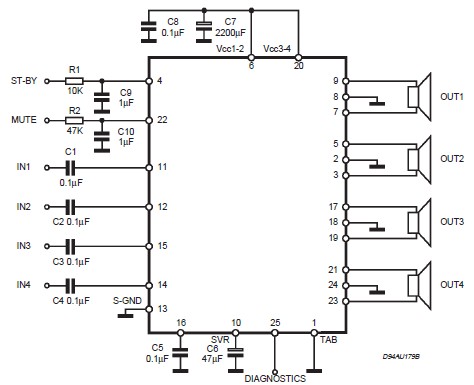
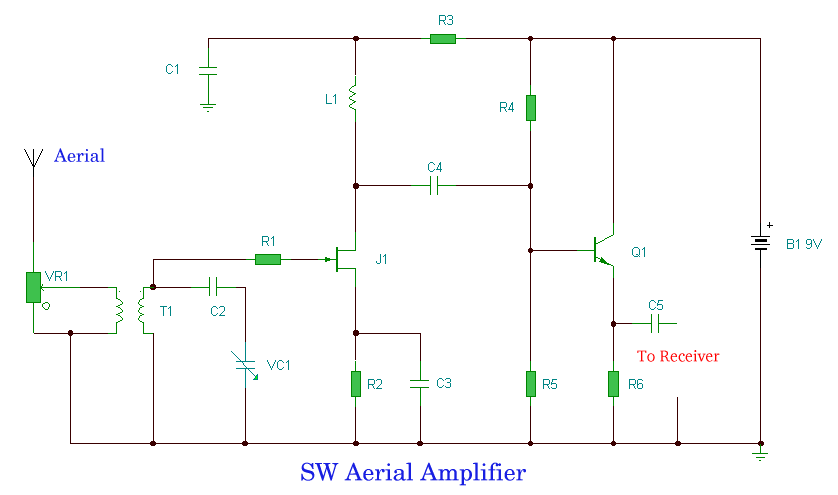
.gif)
